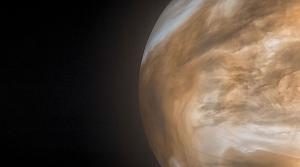Blog
Scale of Life
7 February 2021
 JAXA / ISAS / DARTS / Damia Bouic
JAXA / ISAS / DARTS / Damia BouicPerhaps the greatest unanswered question in astronomy is whether life exists on other worlds. One way extraterrestrial life might be discovered is by detecting its chemical signature in the atmosphere of an alien world. Many chemical compounds are commonly produced by life on Earth. If we were to find them in an exoplanet’s atmosphere, it could be proof of life. But verifying such a chemical signature is extremely difficult, as recently seen in studies of the atmosphere of Venus.
Venus is a hellish world, with sulphuric acid rain and a surface temperature hot enough to melt lead. But there is a layer of the atmosphere that could potentially harbor life. The layer has a temperature similar to that of Earth, and there is plenty of rich chemistry in the layer to form complex molecules. It’s an interesting idea, but there has been little evidence for life on Venus.
In September of 2020, a team announced that they had detected significant quantities of phosphine in this layer.1 Phosphine breaks apart quickly when exposed to ultraviolet light, so the Venusian phosphine would need to be constantly replenished. Since only organic processes are known to produce phosphine in such quantities, this discovery pointed to the existence of life on Venus. But a new study finds the evidence for life isn’t very strong after all.2
Astronomers identify molecules in a planet’s atmosphere by looking at the spectrum of light absorbed or emitted by those molecules. Each type of molecule has a specific spectral pattern, like a unique fingerprint. While molecular patterns are unique, they can be quite similar, so astronomers must do checks to very they identify the right pattern.
When the original team identified phosphine, they knew that its pattern is similar to another molecule known as sulfur dioxide. The atmosphere of Venus is known to have sulfur dioxide, so the team used data from ALMA observatory to verify their data. They found both phosphine and sulfur dioxide, but in the atmospheric layer that could harbor life, the phosphine lines were much stronger than the sulfur dioxide ones. Thus it seemed their signature of life was valid.
But not so fast. As this latest study shows, with ALMA you have to be very careful about comparing molecular lines. ALMA is a high-resolution radio telescope, so it can capture light coming from a small region of Venus, not just Venus as a whole. But this means that the strength of spectral lines can be misleading, thanks to a process known as spectral line dilution.
Imagine seeing a bright red cardinal in a grove of trees. Because you are focused on the cardinal, you don’t notice the trees as much. There is a background of green leaves, but the cardinal stands out. Spectral line dilution is a similar effect. If there is a small pocket of phosphine gas within a wide region of sulfur dioxide, the phosphine lines look stronger, even though there is far more sulfur dioxide. The sulfur dioxide lines are more faded than they should be thanks to spectral line dilution. This new study argues that the original phosphine signature is probably a false positive caused by a broad layer of sulfur dioxide in an atmospheric layer higher than the habitable zone. So no evidence for life after all.
It should be noted that even though the first study was wrong, it was a good study. Spectral line dilution doesn’t occur with most radio telescopes, so it’s no surprise they didn’t pick up on it. By publishing their work openly, other research groups could analyze the results and look for errors. This is how science works. Even when a paper passes peer review it can still be overturned.
This also shows how difficult it will be to discover alien life. Venus is in our solar neighborhood. We know a great deal about it, and it was still a challenge to confirm the source of this chemical signature. Imagine how difficult it will be to do this kind of study on a planet light-years away.